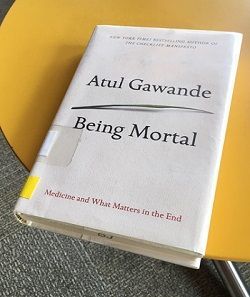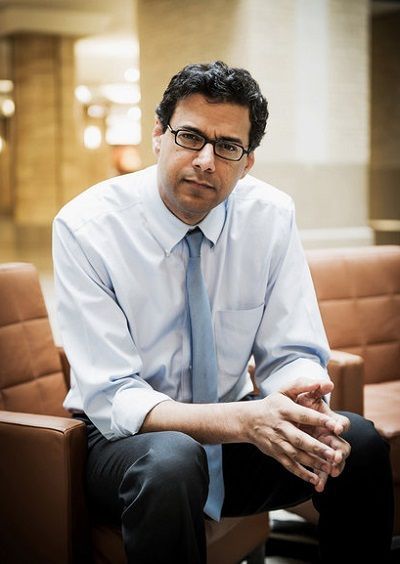Article
Atul Gawande's 'Being Mortal' Calls for New Approach to Geriatrics
Author(s):
In his new book, "Being Mortal," Atul Gawande, MD, writes that the western fear of death has caused our modern healthcare system to go awry. He argues a new approach is needed in order to help patients cope with and understand terminal illness.

No one doubts that Atul Gawande, MD is a capable surgeon or a more than competent writer. He wrote his fourth nonfiction book, Being Mortal, from his experiences as a practicing Boston surgeon and probably more importantly from talking to patients who were, in a way, trapped within the American medical system. It’s a system in which, he says, given “the inescapable realities of aging and death, what medicine can do often runs counter to what it should.”
He ends his book with a tribute to his father, a urologist, who died bravely from a spinal cord malignancy.
I thought this book was a tribute also to its author, a kind, sympathetic person that any reader could embrace as his own doctor. As a British-trained doctor who has been an American family physician for more than 40 years with a long interest in geriatrics, I have always thought that in final medical care more is not better — despite the enthusiastic, almost evangelistic, belief here in the United States that death is the enemy. Sometimes death can come to patients in extremis as a friend.

Author Atul Gawande photograph, by Tim Llewellyn
My surprise on reading Being Mortal was not that Professor Gawande, a surgeon on the faculty of Harvard Medical School and the Harvard School of Public Health and the winner of a MacArthur Fellowship and several important book awards, could write such a fascinating and detailed book. My surprise was that someone from the ivory towers of academe could have such insight into what it’s like for doctors struggling with issues in the trenches and could write such sense about patients who are similarly struggling.
I recall it was academic medicine 25 years ago that changed the new specialty of geriatrics. We went from an arena where a personal physician working one on one with elderly fragile patients could meet patients’ needs to a new concept suggesting that teams of physicians, nurses, dieticians, nutritionists, social workers and statisticians were the geriatric gold standard as existed in academic medicine. Such a “medical home” was unobtainable in private practice; health insurance companies would not pay for it, and all the new title of board-certified geriatrician did for the medical profession was create about 3,000 newly minted physicians in 1988-1990 after the first two geriatrics examinations. Within a few years, I read, the number had dropped to 2,000 because the new geriatricians found, in group practice, their colleagues, who preferred simpler problems (at a time before health insurance companies “paid more for difficult patients”), dumped all their complicated cases on them, so in self-defense the new specialists concealed their geriatrics certification.
How many board-certified geriatricians have we added from 2004 to 2013? The latest 2014 report from the American Board of Medical Specialties shows that in the subspecialty of geriatrics in family practice we now have 2,141 geriatricians and in internal medicine 5,040 for a total of 7,181, with a number adding up to 7,428 if you include geriatric psychiatrists — and you should. Those two fields, family medicine and internal medicine, however, have added only 2,835 geriatricians in the last ten years! Family Practice, itself, has added 805 geriatricians from 2004 to 2013 while in the same period added 1,086 sports medicine specialties!
An article in everyday health points out we are not paying attention to our future: “The geriatrician is an endangered specialist.” Gawande quotes a geriatrician Felix Silverstone, who explains, not unkindly, that mainstream doctors do not have the facilities to cope with “the Old Crock.” Silverstone then gives a detailed, deep explanation as to why elderly patients can be time consuming without meaning to be difficult.
The belief that we are not treating many of our elderly the way we should does not require geriatrician wisdom, however, just the awareness of sensitive and compassionate medical observers who can render articulate opinions as Atul Gawande does and can tell us what’s going on in America.
Gawande says that popular published books on aging are deceptively titled, for example, Younger Next Year or — his favorite -- The Sexy Years, and points out there are “costs to averting our eyes from the realities [of aging]. We put off dealing with the adaptions that we need to make as a society.” He studied a program at the University of Minnesota that divided 568 men and women over the age of 70 and at risk of becoming disabled into two groups: one half randomly assigned to a team of geriatric nurses and doctors and the other half asked to see their regular doctor who was notified this group was of high risk. “Within eighteen months 10 percent of the patients in both groups had died. But the patients who had seen a geriatric team were a quarter less likely to become disabled and half as likely to develop depression. They were 40 percent less likely to require home health services.”
After this result was published, the university closed the division of geriatrics. Apparently “it simply could not sustain the financial losses,” the lead investigator said.
Although Gawande has a lot to say about how the fragile elderly need to be treated he is at his most empathic when he discusses the issue of over-treating the dying in hospitals versus the value of involving hospice service: “We [patients] imagine we can wait until the doctors tell us there is nothing more they can do. But rarely is there nothing more that doctors can do… There is the default of Do Something. Fix Something.”
I remember a young ER doctor once telling me that he always had time to consider what to do with a moribund patient, “We can keep any patient alive for one hour!” he said, “and maybe show at the end of that time a ‘do not resuscitate’ label is not the way to go.” The reality is that in the Western world where death is always seen as the enemy we have not been good at finding out what our elderly patients want when they are close to the conclusion of their life. Gawande’s dismay that we over-treat dying patients when they could be more kindly treated in a hospice setting is not new. Many have written about this for more than a decade. I wrote in December 2002 on this theme (that there may be better ways to die) when I was an OpEd contributor at a publication of the AMA called American Medical News that ceased publication in September 2013 — maybe due to my writing.
There are better ways to die. Gawande refers to a 2010 Massachusetts General Hospital study where 151 patients with Stage IV lung cancer were treated differently, half with the usual oncology, the other half with the usual oncology plus parallel visits with a palliative care specialist. The result was the latter group stopped chemotherapy sooner, entered hospice far earlier… and lived 25% longer. Says Gawande: “The lesson seems almost Zen: you live longer only when you stop trying to live longer.”
Gawande puts it this way, “Death is the enemy. But the enemy has superior forces. Eventually, it wins. And in a war that you can’t win, you don’t want a general who fights to the point of total annihilation. But you don’t want Custer. You want Robert. E. Lee, someone who knows how to fight. More often those days medicine seems to supply neither Custers nor Lees.
“People die only once. They have no experience to draw on. They need doctors and nurses who are willing to have the hard discussions and say what they have seen, who will help people prepare for what is to come — and escape the warehoused oblivion that few really want.”
Atul Gawande is not defeatist. You have to read his entire book to understand his views; you need more than a mere review of it. He does not feel we should just let ill patients die. Gawande summarizes it with this, “We’ve been wrong about what our job is in medicine. We think our job is to ensure health and survival. But really it is larger than that. It is to enable well-being. And well-being is about the reasons one wishes to be alive.” And people treated kindly, sometimes under hospice, with understanding at the end of their life, whose wishes are understood, and followed, surely enjoy more of this time that is left them.
Photography by the author and Tim Llewellyn
Anderson, a retired MD, is the one-time president of the New Hampshire Academy of Family Physicians. He wrote a monthly column “From the Trenches” for Geriatrics for four years and a “Physicians-At-Large" column for Postgraduate Medicine for 14 years. He has written five books, the last called The Man Who Cried Orange: Stories from a Doctor's Life.




